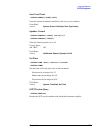
Chapter 5 329
Language Reference
TRACe Subsystem
NOTE This command does not allow setting all trace points to the same amplitude value
by sending just a single value. If you need to set all trace points to the same value,
you must send the same value to each trace point.
Rawtrace data is available with UINT,16 or INT,32 formatting. It is unitless,
returns uncorrected ADC values, and is the fastest method of obtaining
measurement data.
Example: :TRAC:DATA TRACE1,#41604<binary trace
data><LF–EOI>
Remarks: Commands :MMEM:STOR:TRAC and :MMEM:LOAD:TRAC are
used to transfer trace data to, or from, the internal hard drive or
floppy drive of the instrument.
The number of points in a trace is specified by
[:SENSe]:SWEep:POINts. The trace data format is
determined by :FORMat[:TRACe][:DATA], and the binary
data byte order is determined by :FORMat:BORDer.
If the parameter to the query is LLINE1 or LLINE2, a very large
positive or negative value is returned at any point outside the
range of limit values. A large positive number is returned for an
upper limit, and a large negative value for lower limits. There is
no SCPI short form for parameters LLINE1|LLINE2.
Exchange Traces
:TRACe:EXCHange <trace_1>,<trace_2>
Exchanges 2 traces, point by point and leaves both in VIEW mode.
Trace_1 choices are: TRACE1|2|3
Trace_2 choices are: TRACE1|2|3
Example: :TRAC:EXCH TRACE3,TRACE2
Front Panel
Access:
View/Trace, Operations, 1 <–> 3
View/Trace, Operations, 2 <–> 3
Trace Math Add
:TRACe:MATH:ADD
<destination_trace>,<source_trace1>,<source_trace2>
Adds the magnitudes of the two source traces and places the result in the
destination trace.
Destination traces are: TRACE1|2|3
Source traces are: TRACE1|2|3


















